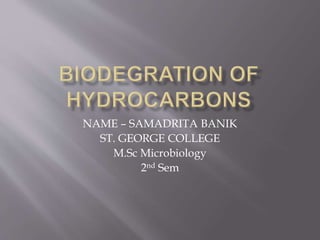Biodegration of hydrocarbons
•Download as PPTX, PDF•
1 like•49 views
MICROBIOLOGY
Report
Share
Report
Share

Recommended
More Related Content
What's hot
What's hot (20)
Biosynthesis and pharmaceutical applications of alkaloids [autosaved]![Biosynthesis and pharmaceutical applications of alkaloids [autosaved]](data:image/gif;base64,R0lGODlhAQABAIAAAAAAAP///yH5BAEAAAAALAAAAAABAAEAAAIBRAA7)
![Biosynthesis and pharmaceutical applications of alkaloids [autosaved]](data:image/gif;base64,R0lGODlhAQABAIAAAAAAAP///yH5BAEAAAAALAAAAAABAAEAAAIBRAA7)
Biosynthesis and pharmaceutical applications of alkaloids [autosaved]
best presentation on organic chemistry (mechanism )

best presentation on organic chemistry (mechanism )
Similar to Biodegration of hydrocarbons
Similar to Biodegration of hydrocarbons (20)
CARBOXYLIC-ACID-DERIVATIVES_20230925_091857_0000.pdf

CARBOXYLIC-ACID-DERIVATIVES_20230925_091857_0000.pdf
Aldehydes-and-Ketones-by-Group-6_20230920_072912_0000 (1).pdf

Aldehydes-and-Ketones-by-Group-6_20230920_072912_0000 (1).pdf
Alcohol & Ether-Chemistry [Gujarat Board-XII-Sem-3-Ch-7]![Alcohol & Ether-Chemistry [Gujarat Board-XII-Sem-3-Ch-7]](data:image/gif;base64,R0lGODlhAQABAIAAAAAAAP///yH5BAEAAAAALAAAAAABAAEAAAIBRAA7)
![Alcohol & Ether-Chemistry [Gujarat Board-XII-Sem-3-Ch-7]](data:image/gif;base64,R0lGODlhAQABAIAAAAAAAP///yH5BAEAAAAALAAAAAABAAEAAAIBRAA7)
Alcohol & Ether-Chemistry [Gujarat Board-XII-Sem-3-Ch-7]
Insecticide Metabolism & Microsomal Oxidation.pptx

Insecticide Metabolism & Microsomal Oxidation.pptx
More from AnuKiruthika
More from AnuKiruthika (20)
Recently uploaded
https://app.box.com/s/z2cfx5b2yooxq1ov1wrd1dezn6af36uxBỘ LUYỆN NGHE TIẾNG ANH 8 GLOBAL SUCCESS CẢ NĂM (GỒM 12 UNITS, MỖI UNIT GỒM 3...

BỘ LUYỆN NGHE TIẾNG ANH 8 GLOBAL SUCCESS CẢ NĂM (GỒM 12 UNITS, MỖI UNIT GỒM 3...Nguyen Thanh Tu Collection
This presentation was provided by William Mattingly of the Smithsonian Institution, during the fifth segment of the NISO training series "AI & Prompt Design." Session Five: Named Entity Recognition with LLMs, was held on May 2, 2024.Mattingly "AI & Prompt Design: Named Entity Recognition"

Mattingly "AI & Prompt Design: Named Entity Recognition"National Information Standards Organization (NISO)
Recently uploaded (20)
Spring gala 2024 photo slideshow - Celebrating School-Community Partnerships

Spring gala 2024 photo slideshow - Celebrating School-Community Partnerships
Analyzing and resolving a communication crisis in Dhaka textiles LTD.pptx

Analyzing and resolving a communication crisis in Dhaka textiles LTD.pptx
Major project report on Tata Motors and its marketing strategies

Major project report on Tata Motors and its marketing strategies
BỘ LUYỆN NGHE TIẾNG ANH 8 GLOBAL SUCCESS CẢ NĂM (GỒM 12 UNITS, MỖI UNIT GỒM 3...

BỘ LUYỆN NGHE TIẾNG ANH 8 GLOBAL SUCCESS CẢ NĂM (GỒM 12 UNITS, MỖI UNIT GỒM 3...
Sternal Fractures & Dislocations - EMGuidewire Radiology Reading Room

Sternal Fractures & Dislocations - EMGuidewire Radiology Reading Room
DEMONSTRATION LESSON IN ENGLISH 4 MATATAG CURRICULUM

DEMONSTRATION LESSON IN ENGLISH 4 MATATAG CURRICULUM
Graduate Outcomes Presentation Slides - English (v3).pptx

Graduate Outcomes Presentation Slides - English (v3).pptx
Basic Civil Engineering notes on Transportation Engineering & Modes of Transport

Basic Civil Engineering notes on Transportation Engineering & Modes of Transport
How to Send Pro Forma Invoice to Your Customers in Odoo 17

How to Send Pro Forma Invoice to Your Customers in Odoo 17
Mattingly "AI & Prompt Design: Named Entity Recognition"

Mattingly "AI & Prompt Design: Named Entity Recognition"
Trauma-Informed Leadership - Five Practical Principles

Trauma-Informed Leadership - Five Practical Principles
Biodegration of hydrocarbons
- 1. NAME – SAMADRITA BANIK ST. GEORGE COLLEGE M.Sc Microbiology 2nd Sem
- 2. The process of bioremediation, defined as the use of microorganisms to detoxify or remove pollutants owing to their diverse metabolic capabilities is an evolving method for the removal and degradation of many environmental pollutants including the products of petroleum industry
- 3. Hydrocarbons are compounds composed entirely of carbon and hydrogen. Aromatic hydrocarbons, alkanes, alkenes, cycloalkanes, alkynes, and combinations of these compounds comprise different types of hydrocarbons. Complex mixtures of hydrocarbons occur naturally in crude oil and gasoline. Most can be used as substrates in metabolism by bacteria, archaea, fungi, and algae. While fungi and algae degrade hydrocarbons aerobically, bacteria and archaea are capable of both aerobic and anaerobic degradation
- 5. Hydrocarbons are readily degraded under aerobic conditions. Bacteria, fungi, and algae are all capable of aerobic hydrocarbon degradation. In general, alkenes and short-chain alkanes are the most easily degraded, followed by branched alkanes and then aromatics
- 6. Alkanes containing 14 carbons or fewer are prone to volatilization, while alkanes containing more carbons are less volatile. Regardless, alkanes and alkenes, with the exception of cyclic alkanes , are the most readily degraded hydrocarbons with reported degradation of alkanes containing up to 44 carbons. Both alkanes and alkenes are degraded with addition of molecular oxygen. Oxygen availability and the initial step of degradation are rate-limiting
- 7. Aromatic hydrocarbons are generally more difficult to degrade than shorter alkanes and alkenes due to their greater toxicity, yet they are readily degraded aerobically by many bacteria and fungi. Degradability decreases with increasing number of rings and increased molecular size, due to increased hydrophobicity and sorption capacity
- 8. Hydrocarbon degradation under anaerobic conditions is often slower compared to aerobic degradation, due to less favorable reaction energetics with alternate electron acceptors. Despite this limitation, both facultative and obligately anaerobic bacteria and archaea are known to degrade hydrocarbons without oxygen.
- 10. Fumarate Addition Bacteria use fumarate addition to activate alkanes from 3-20 carbons as well as alkyl-substituted aromatics like toluene, xylenes, or methylnaphthalene. Fumarate is a common cellular metabolite that contains two carboxylic acid groups and a double bond.
- 11. Oxygen-Independent Hydroxylation Oxygen-independent hydroxylation can denitrify bacteria metabolizing ethylbenzene. In this pathway, a hydroxyl (-OH) group is added to the C1 carbon on the side chain by ethylbenzene dehydrogenase to form S-1-phenylethanol, followed by oxidation to acetophenone and transformation to benzoyl-CoA and acetyl-CoA
- 12. Carboxylation All mechanisms described to date only apply to hydrocarbons with alkyl groups, and not to unsubstituted aromatic hydrocarbons like benzene or naphthalene. In fact, anaerobic degradation of benzene is much slower than that of toluene, or xylenes, and may not occur at all sites
- 13. Hydrocarbon remediation occurs more quickly under aerobic conditions than anaerobic. The primary concern in in situ aerobic remediation is oxygen delivery and mixing, which may be achieved by a number of previously-established methods including landfarming, sparging, groundwater recirculation, and peroxide addition. However, aerobic remediation is not feasible in all environments, particularly low permeability soils. In these cases, anaerobic bioremediation may be preferred.
- 14. As major components of oil, natural gas and pesticides, these substances contribute to the greenhouse effect and climate change, deplete the ozone, reduce photosynthetic ability of plants, and increase occurrences of cancer and respiratory disorders in humans.